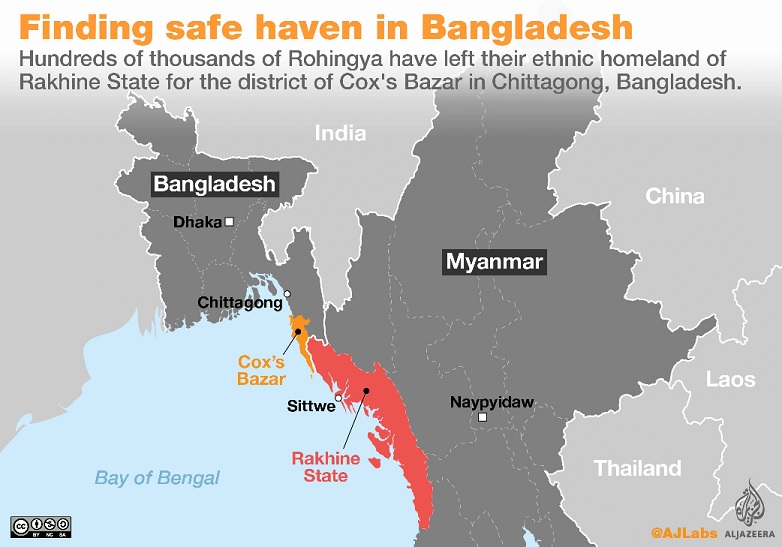Bangladesh’s Rohingya Problem

What is the issue?
Five years after Bangladesh took in thousands of Rohingya driven out of Myanmar, the refugee population is exploding with serious security implications.
What is Rohingya issue?
- The Rohingya are an ethnic Muslim group who reside predominantly in Rakhine state and speak a Bengali dialect.
- They are not recognised by the Myanmar government as an official ethnic group and are therefore denied citizenship under the 1982 Citizenship Law.
- It is claimed that there were no Rohingyas in Myanmar before the British brought ‘Bengalis’ to Burma.
- But, there is sufficient evidence to show that the Rohingyas pre-existed the British-engineered migration during the British occupation of the Arakan State in 1823.
- Even those who arrived in Burma post-1823 could not go back to Bangladesh now given that they have no citizenship claims there.
- This effectively makes them a stateless people.
- They are often said to be the world’s most persecuted minority.
What about the involvement of Bangladesh in this issue?
- Bangladesh has been at the forefront in aiding and providing food and shelter for the refugees and trying to create the conditions in Myanmar for their safe return.
- Since 2017, more than 700,000 Rohingya, fled as the country’s military launched a campaign of terror against the community, including torture, gangrape, mass executions, and the razing of Rohingya villages.
- The Forcibly Displaced Myanmar Nationals (Rohingya refugees) settled in the Kutupalong camp in Bangladesh (the world’s largest refugee camp) and underwent dramatic expansion.

What is the status of repatriating of refugees in Bangladesh?
- According to UNHCR, the United Nations Refugee Agency, there were 926,486 registered Rohingya refugees in Bangladesh as of May 31 2022.
- In the camps, a sharp increase in their population is witnessed due to peace, absence of violent persecution, assurance of food and medical care, etc.
- In 2017, Bangladesh and Myanmar signed a repatriation agreement but the two sides had not agreed on a concrete process or on a deadline for completion of the repatriation.
- In 2018, 2,260 Rohingya were identified for repatriation but the attempt failed as they refused to return to Myanmar without assurances for their safety.
- A tripartite virtual meeting was mediated by China in 2021, but the the Myanmar military staged a coup and put the repatriation process on ice.
When China and Russia supported Myanmar on a UNGA resolution on human rights violations against the Rohingya in 2020, India abstained from the vote.
What are the current issues with the Rohingyas?
- Population- The annual rate of growth of population in Bangladesh is 1%, while the population of the Rohingya is growing at 6 or 7 %.
- Costs- The massive Rohingya population is putting an enormous burden on resources and the environment, besides creating conditions for criminal activity and friction in local society.
- Impact on India– It carries serious social and security implications for the sensitive Northeast India.
- The Rohingya issue has also been the cause of tensions between India and Bangladesh in the past and continues to carry that potential.
- Increase in crimes– Crime such as kidnapping for ransom, petty theft, and dacoity are increasing.
- Organised crimes– Cox’s Bazar (a refugee camp location) occupies a key place on the Bay of Bengal, and some Rohingya have been found to be involved in drugs trade and human trafficking.
- Recruitment hub for extremists– The Rohingya often has little education, and many are angry and desperate, and vulnerable to radical Islamist ideology.
References

